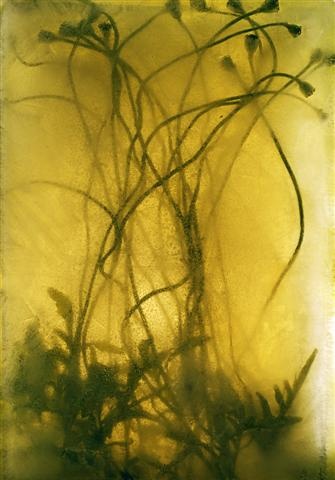Judy Haberl at Gallery Kayafas
Large Scale Polaroids of Icy Worlds
By: Shawn Hill - Apr 06, 2008
Judy Haberl: Unutterable
Gallery Kayfas
61 Thayer @ 450 Harrison Ave.
Boston, MA 02118
March 20—April 26, 2008
http://www.gallerykayafas.com/
Haberl's lush, organic Polaroids are of impossible, fleeting worlds. The realities she conjures are tenuous, impermanent, and fluid, because they are melting away as she photographs them. These large images, like much of her work, mix the organic aspects of texture and growth with man-made and technical materials and substances. Here she suspends objects, from jewelry and dolls to dried herbs and dead leaves, in ice. Refrigeration processes are required to create these works, but the results are abstract, evocative vistas of imagination.
Haberl is primarily a sculptor, and these photos are records of sculptural projects that no longer exist. The "Implications" series are large c-prints, records of works in ice augmented by lighting effects and watery dyes and stains. "Clutch Secrets" are small sculptures, as are "Invitations" (which look like little jeweled sausages and are made of hosiery). All share in common an aspect of having been molded, or produced by molds of varying shapes. That technique, of pressing the fluid into solid form, and letting it set, is the sculptural basis of Haberl's artistic vocabulary.
Transport and permanent display of the ice works would of course be a prohibitively impossible challenge; in order to make the photos Haberl has to rush her creations to a special camera facility in Brooklyn in a refrigerated truck, and they start to melt as soon as the studio lighting hits them. Those records of physical processes, cracks and bubbles in the ice, sheered edges and networks of fractures, are augmented by Haberl with irons and rasps and other tools ice sculptors use.
Some of the photographs are of discreet objects, imaginary vase shapes where instead of the vase we witness the negative space, the full interior, exposed. One features a floating baby head, its eyes forever closed in sleep, amid rosy pinks and sunny blues; a dreamy vista. Others are crammed with jewels, fur, hair, trinkets of treasure meant to be safely stowed away, now somehow vulnerable.
Other images go right up to the ice, with no surrounding space or background, as if we're submerged in watery winter wonderlands. There's a tendency towards prettiness here that can be cloying, as in a field of daisies floating in yellowy silhouettes. But that painterly decorativeness is a part of Haberl's ongoing project, too. Earlier works featured items like bronzed baby shoes and stained baking pans, evidence of Haberl's ability to find and build minimal abstractions from the realm of homey, domestic materials. The inverted vases, the clutches (which use rubber to expose the interiors of clutch purses), not to mention the stockings and costume jewelry, are part and parcel of the home and garden sphere the ice and dried flowers. It all adds up to a feminine mystique as a fertile field of play for Haberl.
The daisies bleed in dark stains from their centers as the ice melts, while two images of poppy tendrils have a loose, looping elegance. There's a hint of the 19th century here in these photographs, an evocation of some of the earliest photographic processes, used to catalog flora for scientific and aesthetic purposes. These preserved poppies have grown into the timeless arabesques of Art Nouveau, a lost world of beauty preserved and somehow awakened in green-stained ice.
The "Clutch Secrets" are both humorous and disturbing. Keys, jewels and other items float as if in amber. But amidst all the feminine finery are braids of hair, small pistols and lengths of rope – the secrets these ladies kept have the film noir tone of the femme fatale.




